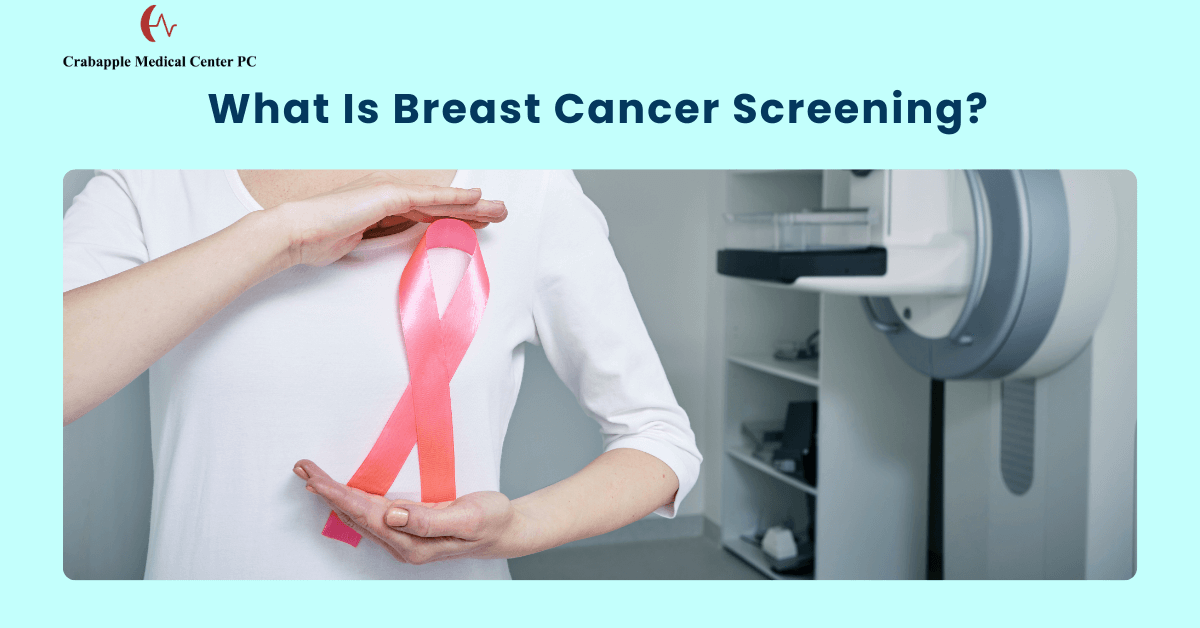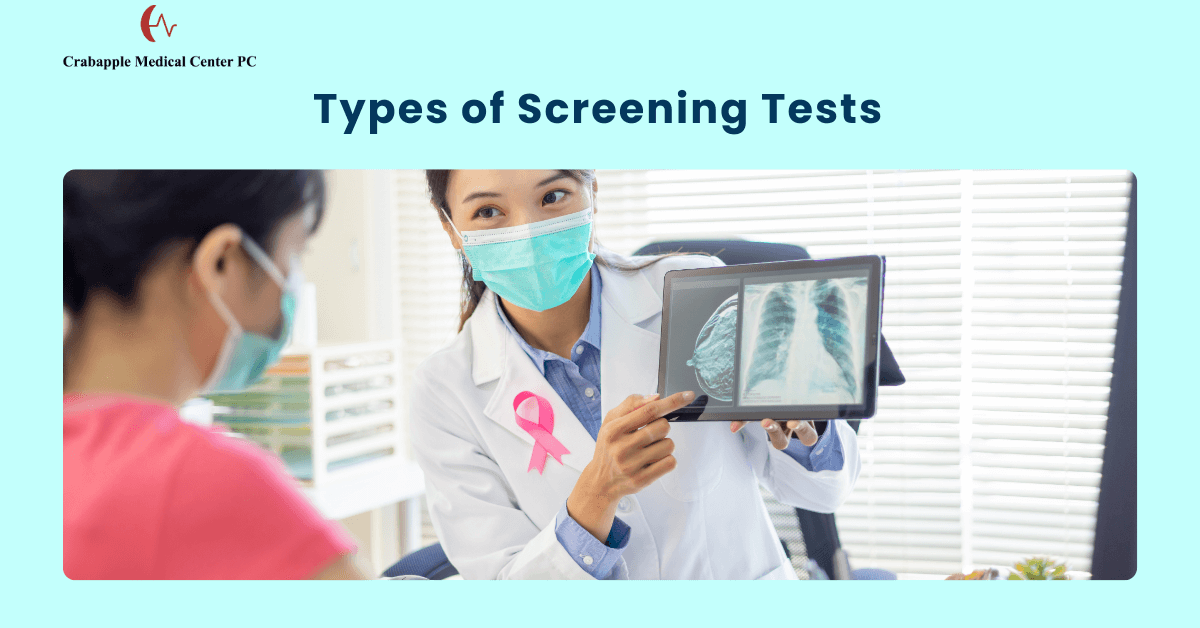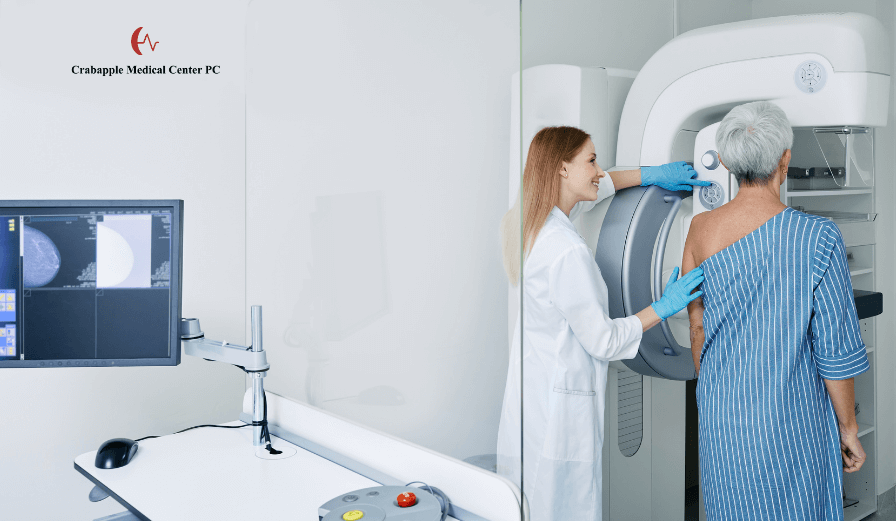Breast cancer is one of the most common and serious health concerns for women in the United States. Yet thanks to advances in screening and diagnosis, it’s also one of the most treatable when caught early.
For women in Alpharetta, GA and surrounding communities, understanding when and how to get screened can mean the difference between simple treatment and a more complex health journey.
At Crab Apple Medical Center, we believe that every woman deserves access to clear information, compassionate care, and the latest screening options.
In this article, we will explore what breast cancer screening is, who should be screened and when, the different screening methods, what to expect, how early detection improves outcomes, barriers to screening, and how Crab Apple Medical Center can support you in taking proactive steps to protect your breast health.

What Is Breast Cancer Screening?
Breast cancer screening refers to tests and tools used to detect cancer in the breasts before symptoms appear. The goal is to find small cancers early; when treatment is simpler, side effects are less, and outcomes are better. Screening is for people without any signs of breast cancer (for example lumps, pain, or visible changes).
Screening is different from diagnostic testing. Diagnostic tests are used when there is a symptom or abnormal finding. Screening is preventive.
Why Early Detection Matters?
Early detection of breast cancer significantly improves survival rates and reduces the need for aggressive treatments. Some of the key benefits include:
- Smaller tumor size at diagnosis, which usually means less invasive surgery and better cosmetic outcomes.
- Lower likelihood that the cancer has spread to lymph nodes or other organs, reducing the need for chemotherapy or radiation.
- More treatment options: early-stage cancers often can be treated with localized surgery and hormonal or targeted therapy rather than large-scale treatments.
- Better quality of life and lower treatment costs, fewer complications, and less physical, emotional, and financial burden.
According to national statistics, breast cancers found during screening exams tend to be smaller and less likely to have spread than those found after symptoms develop.
Easy-to-Follow Screening Schedule
Because risk levels vary, screening schedules are adapted to age, risk factors, and health status. Below are current U.S. guidelines and what Crab Apple Medical Center follows for patients in Alpharetta, GA.
Average-Risk Women
According to the U.S. Preventive Services Task Force (USPSTF), women at average risk should begin screening mammograms at age 40 and have them every two years until age 74.
The American Cancer Society and other organizations recommend that women ages 45-54 have annual mammograms, then switch to every two years at age 55, or continue annual screening depending on patient preference.
High-Risk Women
Women with higher risk for breast cancer (because of strong family history, genetic mutations such as BRCA1 or BRCA2, previous chest radiation, extremely dense breast tissue, etc.) may need to begin screening earlier (often in their 30s) and may be advised to undergo additional screening modalities (MRI, etc.). It’s best to discuss individual risk with a healthcare provider.
Local Guidelines (Georgia / Alpharetta)
In Georgia, women aged 45-54 are recommended to get mammograms every year. Women aged 55 and older should switch to screening every 2 years or continue annually depending on preferences and health status.
At Crab Apple MC we adhere to these standards, adjusting based on patient risk, breast density, and clinical judgment.

Types of Screening Tests
There are several tools used to screen for breast cancer. At Crab Apple Medical Center we offer and/or refer for the following:
Mammography
- 2D mammogram: Standard imaging test using X-ray to view breast tissue. Good for many women.
- 3D mammogram / Digital Breast Tomosynthesis (DBT): Newer technology that takes multiple images from different angles, improving cancer detection especially in denser breast tissue.
Clinical Breast Exam
A medical professional (doctor, nurse) checks breasts for lumps, changes in shape or texture. While not sufficient on its own for cancer detection, clinical exams are a complementary tool.
Breast Self-Awareness
Understanding what is normal for your own breasts (shape, feel, appearance) so that changes such as lumps, skin dimpling, nipple changes are noticed early. Although self-exam as a formal tool has mixed evidence, being aware of one’s own breast changes is helpful.
Supplemental Imaging for Higher Risk / Dense Breasts
For some women, especially with dense breast tissue or other risk factors, mammogram alone may not be enough. Supplemental imaging like breast MRI or ultrasound may be recommended by physicians.
What To Expect During a Screening?
Going in for a screening mammogram or breast cancer screening exam might seem daunting if you’ve never done one before. Here’s what you can expect at Crab Apple Medical Center.
- You’ll fill out a health questionnaire, including personal and family history of breast cancer, prior breast imaging, or any symptoms.
- The mammogram involves placing the breast between plates to compress it briefly for imaging. This may feel uncomfortable but usually lasts a few seconds per view.
- Imaging includes several views of each breast. If DBT or 3D mammography is used, slightly more time may be required.
- After the imaging, a radiologist reviews the images to look for any signs of abnormality. If something suspicious is seen, additional imaging (tomosynthesis slice, ultrasound) or a biopsy may be recommended.
- You’ll receive results within a defined time frame (often 1-2 weeks). For abnormal results, Crab Apple Medical Center provides counselling and guidance for next steps.
Stay Proactive with Routine Screenings
Regular breast cancer screening helps protect your health and gives you peace of mind. Let Crab Apple Medical Center in Alpharetta, GA guide you through each step.
Risks & Considerations of Screening
Screening has many benefits, but also some potential risks or downsides. It’s important to discuss these so you can make informed decisions with your physician.
- False positives: Sometimes imaging shows something suspicious that turns out not to be cancer; this leads to anxiety, and sometimes additional tests which may be invasive.
- Overdiagnosis: Some tumors found might never have caused symptoms or harm during someone’s lifetime; treating them unnecessarily can lead to side effects.
- Radiation exposure: Mammograms use low levels of radiation; risk is small but cumulative exposure is a consideration, especially with frequent imaging.
- Cost and insurance coverage: While many screenings are covered by insurance (especially post-ACA), some women still face out-of-pocket costs, especially for supplemental imaging.
Who Is at Risk
Understanding risk helps tailor the screening plan to your situation. Common risk factors include:
- Age (risk increases with age)
- Family history of breast cancer (first-degree relatives) or known genetic mutations (BRCA1/2, etc.)
- Personal history of breast disease (e.g., atypical hyperplasia)
- Dense breast tissue
- Exposure to chest radiation (especially at young age)
- Lifestyle factors: obesity, alcohol use, hormone replacement therapy, lack of exercise
At Crab Apple Medical Center, we offer risk assessment so that you can understand where you stand and what your screening schedule should be.

How Often Should You Be Screened?
Here’s a simple guideline, to be personalized with your provider:
| Age / Risk Level | Screening Frequency (Mammogram) | Other Considerations |
| Average risk, ages 40-49 | Annually or as advised by provider | Consider shared decision making about benefits vs risks. |
| Ages 50-74 | Every 1-2 years (most commonly every 2) | Continue as long as healthy and life expectancy merits benefit. |
| High risk (family history, genetic, prior radiation, dense breasts) | May start earlier (30s-40s), possibly more frequent | Supplemental MRI or ultrasound, closer follow-up. |
| Over age 75 | Depends on overall health, life expectancy and patient preference | Continue screening if in good health, discuss risks vs benefits. |
Taking Action: What You Can Do
Here are steps you can take to stay on top of your breast health:
- Know your family history and medical history. Share this with your provider.
- Be aware of changes in your breasts: lumps, changes in size or shape, skin changes, nipple changes. Report anything new.
- Schedule your first mammogram by age 40, or sooner if you have risk factors.
- Maintain regular screenings as recommended. Don’t wait for symptoms.
- Discuss breast density with your provider; if you have dense breast tissue, ask if additional imaging is appropriate.
- Stay healthy: maintain a healthy weight, diet, limit alcohol, avoid smoking, exercise regularly. These all reduce breast cancer risk.
Barriers to Screening and How Crab Apple Medical Center Helps
Many women want screening but face obstacles. Understanding these, and how to overcome them, is vital.
Common Barriers
- Cost and insurance coverage issues
- Limited awareness or misconceptions (e.g., “No lump, so I don’t need screening”)
- Access problems: transportation, clinic hours, imaging facility availability
- Fear, anxiety or stigma around screening or potential diagnosis
How Crab Apple Medical Center Supports You?
- We offer flexible appointment scheduling, possibly with early morning/evening options.
- Our staff provide thorough explanations, emotional support, and counselling.
- We accept major insurances, and aid patients in understanding coverage. For those in need, we facilitate referrals or programs for lower-cost or free screenings.
- We ensure convenient location in Alpharetta, working with radiology partners for high-quality mammography and supplemental imaging.
What Happens If a Screening Finds Something?
A screening may lead to further tests. Here’s how we walk you through it:
- If a mammogram or imaging shows an area of concern, we may order additional diagnostic mammography, ultrasound, or MRI.
- A biopsy may be recommended to confirm whether suspicious tissue is cancerous.
- If cancer is detected, treatment options may include surgery, radiation, chemotherapy, targeted therapy or hormonal therapy, depending on the type and stage.
- Throughout, our goal is to support you: explain options, manage health care navigation, provide emotional support, and ensure shared decision-making.
How Crab Apple Medical Center in Alpharetta, GA Helps
At Crab Apple Medical Center, our goal is to make breast cancer screening as accessible, comfortable, and effective as possible for women in Alpharetta, GA and nearby communities. Here’s how we provide support:
- Personalized risk assessment: We review family history, personal health, age, and breast density to tailor screening recommendations.
- High-quality mammography services: We partner with trusted imaging centers offering 2D and 3D mammography, digital mammography, and supplemental imaging when needed.
- Patient education & counselling: We ensure you understand what screening involves, why it matters, and what to expect. We also help address fears, misconceptions, or anxiety.
- Easy scheduling & navigation: Convenient appointments, helpful staff, support handling referrals, insurance, and follow-ups.
- Supportive care during abnormal results: If findings are abnormal, we walk you through diagnostic steps, connect to specialists, and provide emotional and logistical support.
Practical Tips to Be Screening-Ready
To make your screening experience smoother:
- Choose mammogram timing when your breasts are least likely to be tender (often a week after your period).
- Wear a two-piece outfit so you only need to remove your top.
- Avoid using deodorant, antiperspirant, powders, or lotions under your arms or on your breasts on the day of imaging; these can interfere with X-ray images.
- Bring previous mammogram images, if any, for comparison.
- Speak up about breast density or any changes you notice; advocate for imaging that suits your risk.
Empowering Women Through Early Detection at Crab Apple Medical Center
Breast cancer screening is one of the most powerful tools we have in women’s health. Early detection saves lives, reduces treatment complexity, improves outcomes, and gives you more options.
For women in Alpharetta, GA, Crab Apple Medical Center is dedicated to helping you navigate screening guidelines, understand your risk, get access to the best screening tools, and receive compassionate follow-up care.
You do not have to wait for symptoms. If you’re 40 or older, or even younger with risk factors, reach out today. Take charge of your breast health. Because early detection isn’t just a medical decision—it’s empowerment.
Get a Personalized Breast Cancer Risk Assessment at Crab Apple Medical Center
Not sure when to start screening or what tests you need? Our women’s health specialists provide one-on-one consultations to evaluate your personal risk and create a screening plan customized to you.
Frequently Asked Questions
When should I start getting mammograms?
Most women at average risk should begin screening mammograms at age 40. If you have a family history of breast cancer or other risk factors, your healthcare provider at Crab Apple MC may recommend starting earlier.
How often should I have a mammogram?
For average-risk women ages 40 to 74, a mammogram every one to two years is typical. Women at higher risk may need more frequent screening or additional imaging tests such as breast MRI.
Does breast density affect my screening?
Yes. Dense breast tissue can make mammograms harder to interpret and can slightly increase cancer risk. If you have dense breasts, your provider may suggest supplemental imaging like ultrasound or MRI.
What happens if my mammogram shows something abnormal?
An abnormal result doesn’t always mean cancer. Additional imaging, such as diagnostic mammography, ultrasound, or a biopsy, may be needed. We’ll walk you through each step with clear explanations and support.
Can I still get screened if I don’t have symptoms?
Absolutely. Screening is designed for women who have no symptoms so that breast cancer can be detected early, when treatment is most effective.

